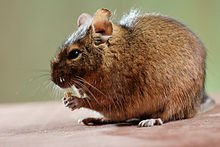Octodontid
| Octodontids Temporal range: Late Miocene–Recent |
|
|---|---|
 |
|
| Octodon degus | |
| Scientific classification | |
| Kingdom: | Animalia |
| Phylum: | Chordata |
| Class: | Mammalia |
| Order: | Rodentia |
| Parvorder: | Caviomorpha |
| Family: |
Octodontidae Waterhouse, 1839 |
| Genera | |
|
Octodon |
|
Octodon
Octodontomys
Octomys
Spalacopus
Aconaemys
Pipanacoctomys
Salinoctomys
Tympanoctomys
Octodontidae is a family of rodents, restricted to southwestern South America. Thirteen species of octodontid are recognised, arranged in nine genera. The best known species is the degu, Octodon degus.
Octodontids are medium-sized rodents, ranging from 12 to 20 cm (4.7 to 7.9 in) in body length. They have long, silky, fur, which is typically brownish in color, and often paler on the underside. The name 'octodont' derives from the wear pattern of their teeth, which resembles a figure 8. Most are nocturnal, social, burrowing animals, though the degu is largely diurnal. They are herbivorous, eating tubers, bulbs, and cactuses.
Some authors have suggested that the octodontids should be reclassified in the order Lagomorpha, but this has not been supported by further analyses (e.g. Opazo, 2005). Older literature includes the tuco-tucos in the family, as the subfamily Ctenomyinae, but these animals are normally now treated as a separate family, Ctenomyidae. Two of the genera now included in this family, Salinoctomys and Pipanacoctomys, have only recently been described. There is some evidence that evolution within the family may have resulted from polyploidy. The red viscacha rat, Tympanoctomys barrerae, is tetraploid, with 102 chromosomes, and the recently described golden viscacha rat Pipanacoctomys aureus has 92.
...
Wikipedia
